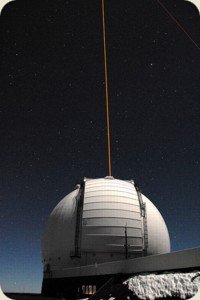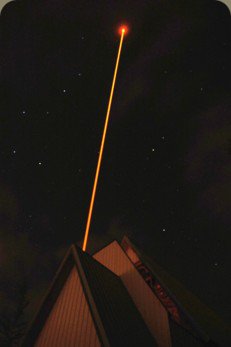Atmospheric Physics
The mesopshere and lower thermosphere, 75 to 120 km in atltiude, is at the "boundary" between Earth and space. Here the density of air is a million times lower than at sea level. Yet it is sufficient to stop millions of tiny pieces of extraterrestrial rock and dust that enter the atmosphere each year. These vaporize, leaving trails that we see as metors. These meteors deposit metalic atoms such as iron, potasium and sodium, which allow the density structure of the region to be probed by lidar.
This region is the coldest place on Earth, with temperatures around -100 C, and winds that often reach 60 m/s (210 km/hr). Our lidar data reveal this to be a very interesting and dynamic region of the atmosphere. Here we see the combined effects of wind, instability, turbulence and gravity (buoyancy) waves. Gravity waves are thought to be generated by mechanical turbulence in the lower atmosphere. As they propagate upward into the low-density mesosphere region, conservation of energy causes the amplitudes of these waves to increase greatly. Here they are revealed as kilometer-scale undulations in layers of enhanced sodium density that form at the crests of the waves. Instabilities can be seen, which disrupt the smooth structure, breaking into turbulence.

The image above shows the sodium density as a function of altitude (vertical, from 75 to 110 km) and time (horizontal, covering 5 hours) above the observatory. Here one can see the layered structure, and oscillations produced by gravity waves.
Astronomy
 Adaptive
optics (AO) is a new technology
that removes the blurring effects of the atmosphere. Light collected by
a
telescope is directed to one or more deformable mirrors, which rapidly
adjust
their shape, to correct wavefront
errors produced by atmospheric turbulence.
This allows ground-based telescope to achieve a resolution
approaching, or even exceeding, that achieved by space telescopes.
Adaptive
optics (AO) is a new technology
that removes the blurring effects of the atmosphere. Light collected by
a
telescope is directed to one or more deformable mirrors, which rapidly
adjust
their shape, to correct wavefront
errors produced by atmospheric turbulence.
This allows ground-based telescope to achieve a resolution
approaching, or even exceeding, that achieved by space telescopes.In order for AO to work, one needs to know what correction is required. This is found by analyzing the light from a star near the object of interest. However, often no stars of sufficient brightness are available, so astronomers use powerful lasers to excite sodium atoms in the mesosphere. These atoms reradiate the laser light, producing artificial "laser guide stars", which provide the needed information for the AO system. The image above shows a sodium laser beam being projected by the Keck II observatory.
The rapid variations that are seen in the sodium density can degrade the performance AO system, which is unable to separate the effects of these fluctuations from those produced by the lower atmosphere, which it is trying to correct. Therefore, detailed knowledge of the mesosphere is needed in order to determine the performance of laser AO systems, and to help develop techniques to mitigate the effects of sodium variability.
